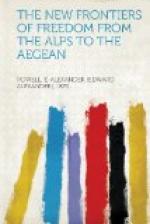so characteristic of the Trentino, giving place to
pointed steeples faced with colored slates or tiles.
On the German side the towns are better kept, the
houses better built, the streets wider and cleaner
than in the Italian districts. Instead of the
low, white-walled, red-tiled dwellings so characteristic
of Italy, the houses begin to assume the aspect of
Alpine chalets, with carved wooden balconies and steep-pitched
roofs to prevent the settling of the winter snows.
The plastered facades of many of the houses are decorated
with gaudily colored frescoes, nearly always of Biblical
characters or scenes, so that in a score of miles
the traveler has had the whole story of the Scriptures
spread before him. They are a deeply religious
people, these Tyrolean peasants, as is evidenced not
only by the many handsome churches and the character
of the wall-paintings on the houses, but by the amazing
frequency of the wayside shrines, most of which consist
of representations of various phases of the Crucifixion,
usually carved and painted with a most harrowing fidelity
of detail. Occasionally we encountered groups
of peasants wearing the picturesque velvet jackets,
tight knee-breeches, heavy woolen stockings and beribboned
hats which one usually associates with the Tyrolean
yodelers who still inflict themselves on vaudeville
audiences in the United States. As we sped northward
the landscape changed with the inhabitants, the sunny
Italian countryside, ablaze with flowers and green
with vineyards, giving way to solemn forests, gloomy
defiles, and crags surmounted by grim, gray castles
which reminded me of the stage-settings for “Tannhaeuser”
and “Lohengrin.”
Seen from the summit of the Mendel Pass, the road
from Trent to Bozen looks like a lariat thrown carelessly
upon the ground. It climbs laboriously upward,
through splendid evergreen forests, in countless curves
and spirals, loiters for a few-score yards beside the
margin of a tiny crystal lake, and then, refreshed,
plunges downward, in a series of steep white zigzags,
to meet the Isarco, in whose company it enters Bozen.
Because the car, like ourselves, was thirsty, we stopped
at the summit of the pass at the tiny hamlet of Madonna
di Campiglio—Our Lady of the Fields—for
water and for tea. Should you have occasion to
go that way, I hope that you will take time to stop
at the unpretentious little Hotel Neumann. It
is the sort of Tyrolean inn which had, I supposed,
gone out of existence with the war. The innkeeper,
a jovial, white-whiskered fellow, such as one rarely
finds off the musical comedy stage, served us with
tea—with rum in it—and hot bread
with honey, and heaping dishes of small wild strawberries,
and those pastries which the Viennese used to make
in such perfection. There were five of us, including
the chauffeur and the orderly, and for the food which
we consumed I think that the innkeeper charged the
equivalent of a dollar. But, as he explained
apologetically, the war had raised prices terribly.




